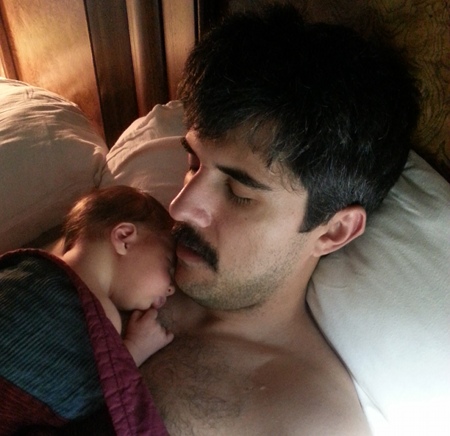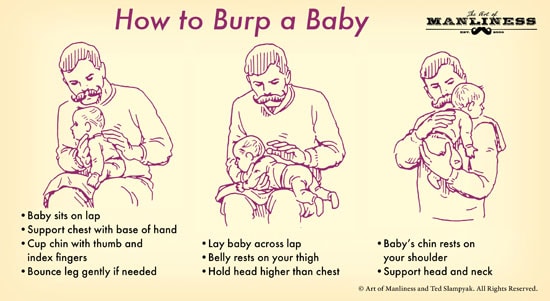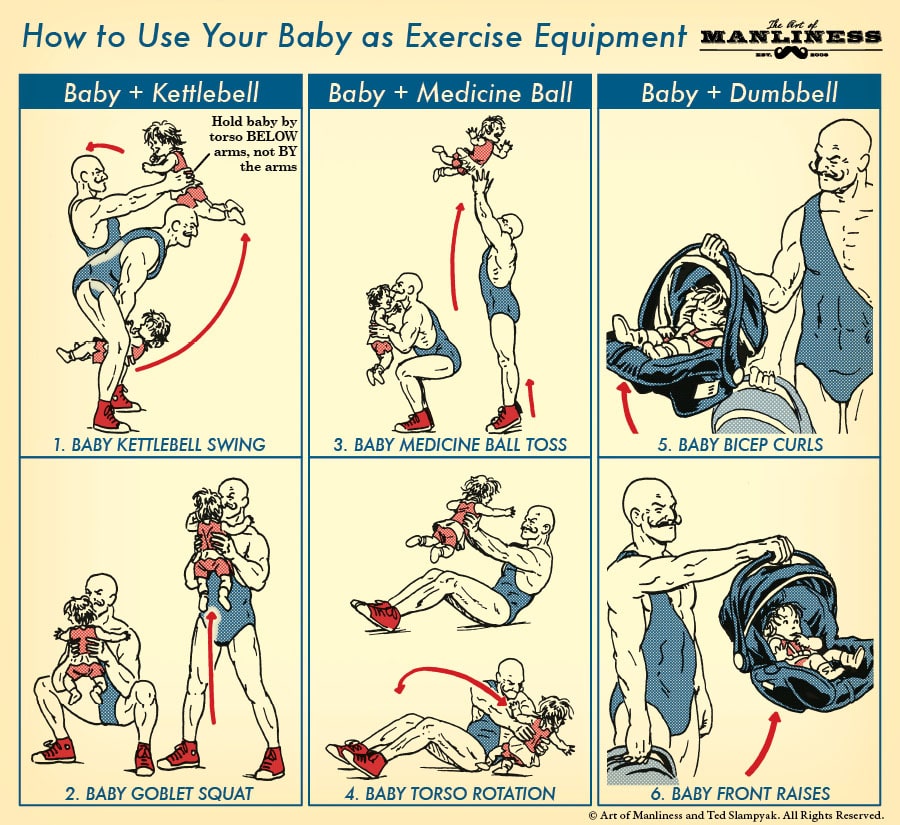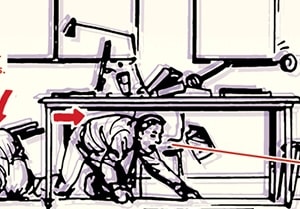
When my daughter Scout recently passed the 3-months-old mark, I found myself reflecting on how smoothly adding her into the family has gone. Every newborn brings a certain degree of chaos into your life, but throwing baby #2 into the mix has been surprisingly chill.

Me & a newborn Scouter
But oh, ho, ho, was baby #1 a whole different story! When Gus arrived on the scene he turned our formerly childless life upside-down. Charlie at How to Be a Dad jokingly compares the experience of having your first kid to being deployed to Nam and jumping out of a chopper into “a jungle bristling with booby traps of dung-encrusted bamboo stakes.” That about sums it up.
According to a survey by Esquire Magazine, more than a third of men spend about the same amount of time caring for their kids as their spouse does. That’s how it is around the McKay household and I wouldn’t want it any other way; I love being a really involved, hands-on dad. I know a lot of men in my generation feel similarly; according to that same Esquire survey, men ages 18-29 are much more likely to spend as much, or even more time with their kids than their spouses. Yet desire doesn’t always translate immediately into ability.
For several months after you have your first child, life can feel pretty chaotic. You may have never cared for a baby before, have no idea what you’re doing, and feel majorly stressed and overwhelmed. You want to do the right thing for your kid, but you’re worried you might accidentally kill him.
There is a lot to fathering that you just have to learn from trial and error. But preparing your mindset and honing your skillset before your progeny arrives can help the experience of being a new dad go more smoothly. So today we’ll talk about the how-tos and tomorrow the preservation of your sanity.
They don’t hand out an instruction manual in the delivery room, but if they did, these two posts will cover what it ought to say.
New Dad Survival Guide: The Skillset
With all of the baby-handling tips outlined below, don’t worry so much about hurting your baby. They’re not as fragile as you think. Sturdy little buggers, really.
Starting Things Off Right: Give Your Baby Skin-to-Skin Contact

Leaving the womb and suddenly becoming untethered in the wide, wide world can be a stressful experience for babies. Unsurprisingly, studies have shown that holding your baby skin-to-skin can calm and comfort him — stabilizing his heart rate, respiratory rate, and blood pressure, maintaining his body temperature, and decreasing his crying. It also helps you bond with your baby. These benefits occur whether it’s the mother or the father engaging in the skin-to-skin contact. Soon after your baby is born, and for the next few weeks, spend some time with your shirt off, holding him just in his diaper.
How to Hold a Baby

Whatever hold you use, the important thing is supporting your baby’s neck, bottom, and small of the back.
How to Change a Diaper
“Spread the diaper in the position of the [baseball] diamond with you at bat. Then fold second base down to home and set the baby on the pitcher’s mound. Put first base and third together, bring up home plate, and pin the three together. Of course, in case of rain, you gotta call the game and start all over again.” —Jimmy Piersall, MLB center fielder, on how to diaper a baby
A new baby is a poop and pee machine. You’ll be amazed that such a small person can produce so much waste. With a newborn, you can expect to change a diaper every two hours. That’s twelve changes in a single 24-hour day! Wowza! As the baby gets older, the changings will get less frequent, but you’ll still be plowing through a lot of diapers. Unfortunately science has yet to create a self-cleaning baby, so it’s up to you and your wife to clean your little tyke and keep their waste-producing faculties in shipshape condition.
1. Assess the damage. If you smell something funky, you know you need to change your little turd machine’s diaper. When you go to check the damage, be prepared for anything. You might have just a small little nugget waiting for you, or you could have a runny, hazardous waste explosion that has left the confines of the diaper. If it’s the latter, it’s best to move the baby near the bath, so you can thoroughly clean her.
2. Get your materials. Grab a clean diaper and four or five baby wipes (if it’s #2). Place them to the side.
3. Put your gas mask on and assume the position. If your baby is formula fed, be prepared for a pretty potent smell. If your baby is breastfed, the stink isn’t quite as bad. If you have a boy, it’s always a good idea to juke to the side lest his little sprinkler baptize you into the Church of the Yellow Stream.
4. Undo the dirty diaper and lift up your baby’s butt. Lifting of the tuckus can be done by grabbing your baby’s ankles and gently hoisting her feet into the air. Use a clean part of the dirty diaper to wipe any excess poo from her behind.
5. Wipe. With your baby’s little butt lifted off the ground, grab a baby wipe and start wiping front to back. The front to back motion reduces the chance of spreading bacteria into their privates, which can cause a urinary tract infection (especially important for girls). Make sure you don’t miss a spot. Place the used wipes on top of the soiled diaper. Then, with your baby’s feet still suspended in the air, remove the soiled diaper.
6. Close the dirty diaper and dispose. Fold the diaper on itself with the hazardous waste and used wipes still in it. Use the sticky tabs to make a tight bundle. Place inside a plastic bag, tie the bag off, and hook shot the bundle into the diaper bin.
7. Pat dry. If you want to avoid diaper rashes, make sure your baby’s bottom is nice and dry. Apply some A&D or Desitin if her butt is red or irritated.
8. Slide the new diaper under your progeny. In order for a diaper to function correctly, it needs to be on right. The back of the diaper has the sticky tabs on it. Lay your baby down on this part.
9. Bring up the front of the diaper and attach the tabs. You want it tight enough so that it doesn’t slide off but not so tight it cuts off circulation to your baby’s legs. Most disposable diapers have little ruffles around the leg. Make sure those are sticking out, or you’ll have some leaking problems.
10. Give your baby a high five.
How to Burp a Baby

With all of these methods, give your baby gentle pats or small, circular rubs to get the burp out.
Babies get gas from sucking in air whilst feeding. Burping helps them get these air bubbles out. If you’re feeding a baby with a bottle, burp her after every 2-3 ounces she drinks, as well as at the end of her feeding. If she’s fussy or spits up a lot, trying burping even more often during the feeding.
How to Calm a Crying Baby
The most important skill to have as a new dad (if you wish to maintain your sanity) is being able to calm your baby when she cries.
Whether your baby cries a lot or a little will largely determine whether your new dad experience seems easier than you thought or a whole lot harder. Unfortunately, whether you get a really happy baby or a cantankerous caterwauler is pretty much a crapshoot. Regardless of the straw you draw, here’s how to soothe their wailing.
Why is my baby crying?
It may seem like your baby is crying as part of some malevolent plot to melt your brain. But usually there’s a reason; remember, when something is bothering her, she doesn’t have any way to communicate besides howling. Therefore, when you’re trying to soothe your scream-machine, it’s helpful to run through a mental checklist of what could be putting a bee in her bonnet:
- Dirty diaper? Doesn’t have to be full of #2. A big ol’ wet, soggy diaper can bring them to tears too.
- Needs to burp? Try the different positions outlined above to get the burp out.
- Gas? Try laying your baby on her back and then moving her legs and hips up and down like she’s riding a bicycle. Or gently massage her tummy in a circle. You can try over-the-counter remedies like simethicone and “gripe water,” but they haven’t been proven to work and honestly we had zero success with them with either of our kids. I think when people believe they work, the gas would have gone away on its own anyway.
- Physical discomfort? Is the baby too hot or cold? Is there something on her that’s too tight or scratchy? I once had a very fussy Scout on my hands, and she wouldn’t calm down no matter what I tried. I was getting pretty annoyed with her, when I realized the little pieces of hair that had stuck to me after getting a haircut that morning were now all over her. Gave her a bath, and once again had a happy baby on my hands.
- Lonely? The world is a big, unfamiliar place for your baby. If she wakes up and no one is around, she might cry out for some company and just want to be held.
- Overstimulated? The womb was a pretty boring hang-out, so too much new stimuli all at once can make your baby feel overwhelmed. Take her somewhere quiet to decompress.
- Hungry? Give her a bottle or hand her over to mom for some boob juice.
- Tired? Time for a nap.
- Fever? An easy-to-use forehead thermometer is a must for when you have a baby. If the reading says she’s running a temperature, you can give her some acetaminophen. Be sure to check with you doctor for the right dosage.
Crying Remedies
If you go through your checklist, and none of the fixes stop your baby’s wailing, you may just have a case of undiagnosed crankiness. Happens to all of us. Here are some potential soothers:
- Stick a cork pacifier in it. Not all babies take to the pacifier, and there are pros and cons to using one, but they can definitely work wonders in silencing a cantankerous newborn.
- Put the baby in a motorized swing. Neither of our babies ever really liked the ubiquitous baby swing, but works like a charm for others.
- Swaddle. Babies like being tightly wrapped – it reminds them of being back in the womb. Swaddling a baby using a blanket is pretty simple – but we really like these Velcro swaddlers for further idiot-proofing the process.
- Run the vacuum. The womb was a surprisingly loud place, so replicating that kind of white noise can put your baby at ease. Running your vacuum next to them can be amazingly effective; it’s like a hypnotist snaps his fingers and says, “Sleep!”
- Take ‘em for a drive. When all else fails, stick the baby in her carseat and take her for a drive. Highly effective at calming a baby down — and your wife will be incredibly grateful to you for removing the scream-machine from the premises.
What if my baby has colic?
If none of the above remedies stop your baby’s caterwauling, and she cries for three hours a day for more than three days a week for three weeks, she has colic. The cause of colic is unknown, and it can wreak havoc on your mental state and your relationship with your wife. My only advice is to try the “5 Ss” (Swaddle, Stomach/Side position, Shush, Swing, Suck) as proposed in The Happiest Baby on the Block and hang in there. Colic often resolves itself around 4-6 months in.
Try to be zen about crying (and walk away if you need to)
Whether your baby has colic or just intermittent fussiness, their cries can really do a number on your equilibrium. Since babies can’t do anything for themselves, their cries are designed by nature to get your attention, burrowing into your brain and refusing to let go until you alleviate their distress. Their wails elicit a real physiological response – you start to sweat, your heart rate goes up, and your body releases cortisol – the stress hormone.
Try to deal with this physiological arousal the way you would any other kind of stressor. I find it helpful to concentrate on disassociating from the cries – I keep telling myself that it’s okay, that it’s just a noise. I also practice my tactical breathing.
Studies have shown that abusive parents have a stronger physiological response to crying, which leads them to lose control. So learning to calm yourself while you’re trying to calm your baby is crucial. Before you have a kid, whenever you see a commercial about not shaking your baby, you can’t help but chuckle and think, “What kind of Grade A moron needs to be told not to shake a baby?” Then, after you have a kid, and it’s 3 am, and you’re holding this little screaming tomato that won’t stop crying, you think, “Oh right, this is why people end up shaking their baby.” You won’t believe how angry you can feel at a little innocent baby — how tempted you are to drop kick them out the window!
If you’ve tried everything above to soothe your baby, and your brain is starting to short-circuit, there’s nothing wrong with putting your baby down in a safe place like her crib, closing the door, going into another room where you can’t hear her cries anymore (you may need to turn on the faucet and the vent), and taking five. Your baby will be fine — really. Far better to let her cry for a little while alone than for you to lose control.
The things outlined above will come more and more naturally with practice. They’re the easy stuff really. More important, and more difficult, is keeping a healthy attitude and perspective on the whole new dad experience. That’s where we will turn tomorrow.
What skills did you have to learn as a new dad? Any tips or tricks for making them a bit easier?







